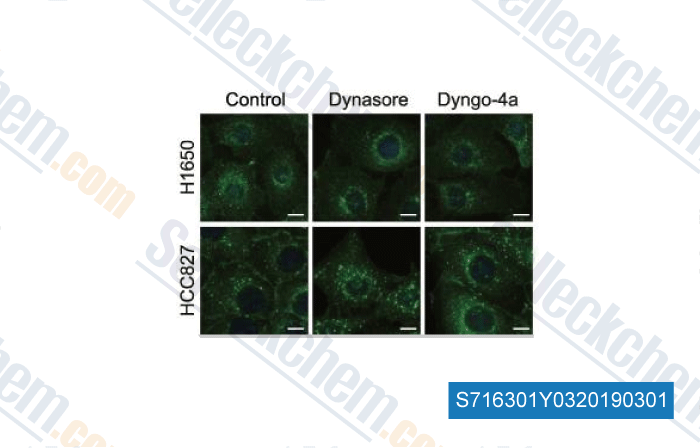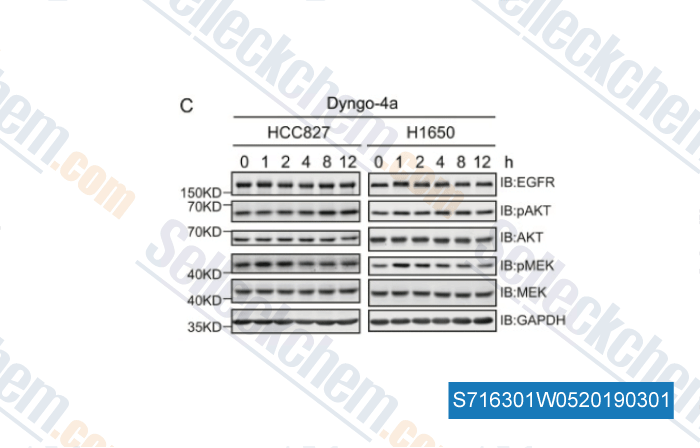|
Toll Free: (877) 796-6397 -- USA and Canada only -- |
Fax: +1-832-582-8590 Orders: +1-832-582-8158 |
Tech Support: +1-832-582-8158 Ext:3 Please provide your Order Number in the email. |
Technical Data
| Formula | C18H14N2O5 |
|||
| Molecular Weight | 338.31 | CAS No. | 1256493-34-1 | |
| Solubility (25°C)* | In vitro | DMSO | 67 mg/mL (198.04 mM) | |
| Ethanol | 1 mg/mL (2.95 mM) | |||
| Water | Insoluble | |||
|
* <1 mg/ml means slightly soluble or insoluble. * Please note that Selleck tests the solubility of all compounds in-house, and the actual solubility may differ slightly from published values. This is normal and is due to slight batch-to-batch variations. * Room temperature shipping (Stability testing shows this product can be shipped without any cooling measures.) |
||||
Preparing Stock Solutions
Biological Activity
| Description | Dyngo-4a is a potent dynamin inhibitor with IC50 of 0.38 μM, 1.1 μM, and 2.3 μM for DynI (brain), DynI (rec), and DynII (rec), respectively. | ||||||
|---|---|---|---|---|---|---|---|
| Targets |
|
||||||
| In vitro | Dyngo-4a inhibits dynamin-dependent endocytosis of transferrin in multiple cell types with IC₅₀ of 5.7 μM, and reduces synaptic vesicle endocytosis and activity-dependent bulk endocytosis in cultured neurons and synaptosomes. [1] In motor nerve terminals and cultured hippocampal neurons, Dyngo-4a blocks Alexa Fluor 488-BoNT/A-Hc internalization. [2] In Drosophila S2R+ cells, Dyngo-4a causes a decrease in the level of Armadillo/β-catenin. [3] |
Protocol (from reference)
| Kinase Assay: |
|
|---|---|
| Cell Assay: |
|
| Animal Study: |
|
References
Customer Product Validation

-
Data from [Data independently produced by , , Cell Commun Signal, 2018, 16(1):40]

-
Data from [Data independently produced by , , J Immunol, 2018, 200(3):997-1007]

-
Data from [Data independently produced by , , Int J Biochem Cell Biol, 2018, 105:1-12]
Selleck's Dyngo-4a has been cited by 29 publications
| Extracellular Histones as Exosome Membrane Proteins Regulated by Cell Stress [ J Extracell Vesicles, 2025, 14(2):e70042] | PubMed: 39976275 |
| Signaling via a CD27-TRAF2-SHP-1 axis during naive T cell activation promotes memory-associated gene regulatory networks [ Immunity, 2024, 57(2):287-302.e12] | PubMed: 38354704 |
| Plasma membrane remodeling determines adipocyte expansion and mechanical adaptability [ Nat Commun, 2024, 15(1):10102] | PubMed: 39609408 |
| RAB22A sorts epithelial growth factor receptor (EGFR) from early endosomes to recycling endosomes for microvesicles release [ J Extracell Vesicles, 2024, 13(7):e12494] | PubMed: 39051763 |
| Peptide nanocarriers co-delivering an antisense oligonucleotide and photosensitizer elicit synergistic cytotoxicity [ J Colloid Interface Sci, 2024, 664:338-348] | PubMed: 38479270 |
| CAPN2-responsive mesoporous silica nanoparticles: A promising nanocarrier for targeted therapy of pancreatic cancer [ Cancer Lett, 2024, 590:216845] | PubMed: 38589004 |
| Gut Bacteria-derived Membrane Vesicles Induce Colonic Dysplasia by Inducing DNA Damage in Colon Epithelial Cells [ Cell Mol Gastroenterol Hepatol, 2024, S2352-345X(24)00010-9] | PubMed: 38309455 |
| Apoptotic signaling by TNFR1 is inhibited by the α2-6 sialylation, but not α2-3 sialylation, of the TNFR1 N-glycans [ J Biol Chem, 2024, 301(1):108043] | PubMed: 39615678 |
| Evidence for a clathrin-independent endocytic pathway for APP internalization in the neuronal somatodendritic compartment [ Cell Rep, 2023, 42(7):112774] | PubMed: 37450368 |
| Endocytosis inhibitors block SARS-CoV-2 pseudoparticle infection of mink lung epithelium [ Front Microbiol, 2023, 14:1258975] | PubMed: 38033586 |
RETURN POLICY
Selleck Chemical’s Unconditional Return Policy ensures a smooth online shopping experience for our customers. If you are in any way unsatisfied with your purchase, you may return any item(s) within 7 days of receiving it. In the event of product quality issues, either protocol related or product related problems, you may return any item(s) within 365 days from the original purchase date. Please follow the instructions below when returning products.
SHIPPING AND STORAGE
Selleck products are transported at room temperature. If you receive the product at room temperature, please rest assured, the Selleck Quality Inspection Department has conducted experiments to verify that the normal temperature placement of one month will not affect the biological activity of powder products. After collecting, please store the product according to the requirements described in the datasheet. Most Selleck products are stable under the recommended conditions.
NOT FOR HUMAN, VETERINARY DIAGNOSTIC OR THERAPEUTIC USE.
